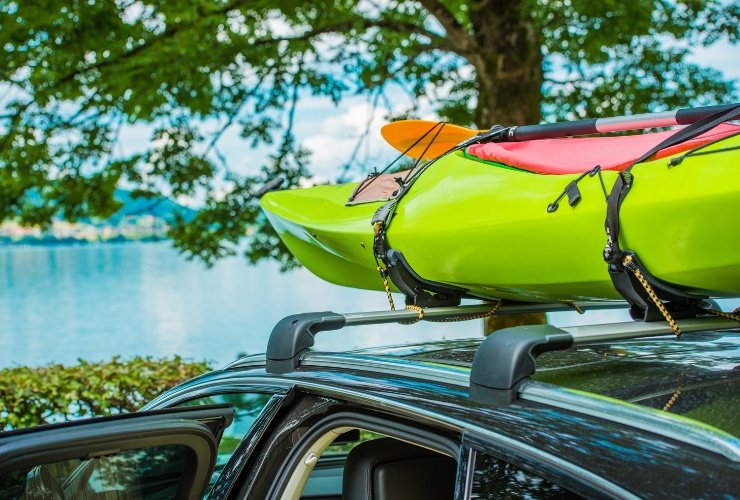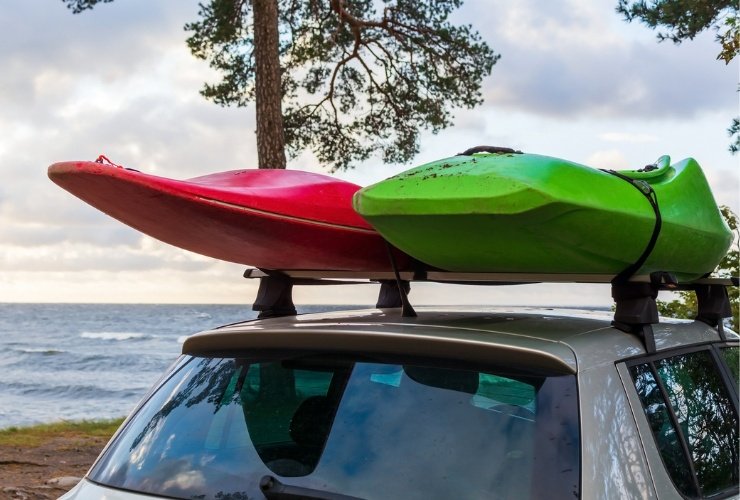Getting your kayak from the land to the water is essential, but we often overlook this element of kayaking. If you have any concerns or are wondering how to transport a kayak on a small car, this step-by-step guide will show you how.
There are some things to consider before you attempt to transport your kayak, and there are several methods you can use depending on what equipment you own.
It should be noted that most kayaks aren’t going to be so heavy that even a small car can’t handle it – but there are some extra safety concerns to understand.
Key Takeaways
- You can transport a kayak on a small car using different methods, such as a trailer, a roof rack, pool noodles, foam blocks, or putting it inside the car.
- Each method has its advantages and disadvantages in terms of ease of use, cost, safety, and legal regulations.
- You should check the weight and length of your kayak, as well as the towing capacity and roof crossbars of your car, before deciding on a method.
- Secure your kayak properly with straps and tie-downs to prevent it from falling off or damaging your car.
- You should also follow the speed limits and local laws when driving with a kayak on your car.
A Step-by-Step Guide To Transporting Kayaks
Many people are scared that their kayak will be too heavy or somehow damage their car, or the kayak is at significant risk of falling off.
As long as you take proper care and precautions, this is extremely unlikely. Many of these concerns stem from the kayak’s closest competitor – the canoe. Canoes are much heavier than kayaks overall.
It’s also important to check in with your state’s local laws and regulations around transport. This is especially true if you put your kayak inside your car (see step 5).
Step 1: Determine if Your Kayak Is Too Big for Your Car
In some cases, the kayak may not be compatible with your car. However, if you’re strapping the kayak to the roof, even a small car can transport it successfully. .
Some people like to move their kayak by packing it into the car’s trunk; this is fine if you have a larger vehicle like a truck. If you load the kayak into the back of your car and more than half of it is sticking out, then this is too long for your car, and you should try a different method.
Unfortunately, if more than half of the kayak is hanging out the back, this means most of the kayak’s weight isn’t supported, and you risk it falling out the back or becoming a hazard to drive with.
Finally, most kayaks aren’t heavier than 200 pounds, but there is an exception. Fishing kayaks are bigger and bulkier, which depending on how much distance you’re covering, may cause some wear and tear on your vehicle.

Step 2: Use the Towing Method
A small car can use this method to tow one or even multiple kayaks (within reason).
For this method you’ll need:
- A Kayak Trailer
- Tow Package
- Car owner’s manual
There are all kinds of kayak trailers on the market that are suitable for small cars. You’ll need to consult your car owner’s manual to check the maximum towing capacity of your vehicle (if you don’t already know this). If you’ve lost the manual then they’re usually available online.
The towing method is excellent because you don’t have to lift your kayak up and down. However, the downside is that the trailer takes much more room (making parking more difficult), and many people prefer to avoid driving with a trailer.
You should be fine if the kayak’s weight combined with the trailer doesn’t exceed your car’s towing capacity.
Step 3: Use a Kayak Roof Rack
The most well-known method is to use kayak roof racks.
For this method, you’ll need:
- Roof rack (sometimes called a kayak rack).
- You might need somebody to help you lift the kayak onto the roof rack.
Roof racks are a set of bars that attach to the top of your vehicle. There are also roof racks on the market specifically designed for kayaks. It doesn’t matter if you have a large or small car; you can use a roof rack to transport your kayak correctly.
A roof rack attaches to crossbars already on your car, which means you might need to use another method if your vehicle doesn’t have these and you’re unwilling to pay for crossbars to be installed.
One of the upsides of having a roof rack is that they make it easy to lock and secure your kayak – most will come with a locking strap, but it’s pretty inexpensive to buy one separately.
A roof rack is great for first-timers who’ve never transported a kayak, as it stays relatively snug and locked in, leading to fewer worries.
The only major downside is that you have to lift your kayak onto the top of your vehicle to secure it to the roof rack – if you need someone to help you, then this increases the likelihood of bashing your car or scraping paint off.
Step 4: Strap Your Kayak to the Roof (If You Don’t Have a Roof Rack)
You’ll want to use this method if your car roof doesn’t have crossbars to attach a roof rack. You can use either pool noodles or foam blocks in place of a roof rack.
Pool noodles are cylindrical pieces of foam that act as a barrier between the kayak and your car. They are an excellent substitute if you don’t have ready-made kayak roof racks.
Here’s how you set up pool noodles as a makeshift kayak rack:
- Set the pool noodles horizontally on the car’s roof (stretching from the passenger side to the driver’s side).
- You’ll want the pool noodles to be far apart enough to fit your kayak’s cockpit from front to back.
- You’ll want the pool noodles to be shorter than the width of your car.
- Thread your cam straps through the pool noodles until there is an even amount of strap from each end.
- Insert your stainless steel/aluminum tubes into the pool noodles.
- Set your pool noodles in place and open your car doors, run your cam straps underneath the roof and tighten them until everything is completely fixed in place (you should not be able to move the pool noodles in any direction).
- Secure your kayak with straps!
Here’s how to make a kayak rack using foam blocks:
- Just like with the pool noodles, you want to get two decently-sized foam blocks (around about 20 inches long, 4 inches wide, and 4 inches high).
- Like the pool noodles, you’ll want to set your foam blocks apart enough so the kayak cockpit fits on.
- Set your kayak on top of the foam blocks facing down, and then use cam straps to tightly secure it to your car roof.
- You might need at least four cam straps to do this.
Step 5: Put Your Kayak Inside Your Car
As mentioned, if your kayak is small enough, you can ignore the car roof altogether and simply stick it in the back of your car.
However, if too much of your kayak sticks out, it becomes a hazard and much harder to secure. In a small car, you will have to leave your trunk open.
Your trunk should have tie-downs to which you can fix your kayak for this method to transport your kayak safely.
While this may seem like the easiest kayak transportation method, it’s the one fraught with the most risk. States have different rules regarding what is considered safe to transport with an open trunk.
Also, if your kayak is sticking out a little bit too much, there’s a risk of it being ejected out of the back of your car in a sudden acceleration or if you’re going up a steep hill.

Transporting a Kayak on a Small Car: Important Information
Beyond learning the different ways you transport kayaks, there are also some other things to consider. It’s important to familiarise yourself with the other important information, questions, and considerations when it comes to transporting a kayak on a smaller car.
What Are the Best Kayaks for Smaller Cars?
Touring kayaks, recreational kayaks, and most one-man kayaks will be absolutely fine on a small car, even most tandem kayaks will be fine.
The exception to the rule here is fishing kayaks – they might just be a little too weighty for your vehicle. While this isn’t a hard and fast rule, it’s something to be aware of if you’re going to be moving long distances.
What Speed Can You Drive With a Kayak on the Roof?
Speed limits aside; you can probably get 65 – 75 mph speeds while you have a kayak on your roof. Just make sure that you are checking that the kayak is still fixed and secure if you cover lots of distance.
Advantages and Disadvantages of Using a Small Car
Small cars are more economical than larger cars. You can cover greater distances and spend less on fuel.
However, you might not be able to transport more than one kayak on a smaller car – there’s only so much space on the roof, and having one or more kayaks teetering off the edge of your roof can be hazardous.
While kayaks don’t weigh that much, in a smaller car, it can be enough to throw off your car’s handling and suspension. This will not be a problem in good weather conditions, but it could be if the weather is bad.
How Do You Transport a Kayak on a 2-Door Car?
You can use any of the methods listed here. However, avoiding stuffing the kayak inside your car would probably be a good idea. Make sure your kayak is nice and sturdy on your roof, and see how it feels.
Conclusion
Kayak transport is an essential part of learning to kayak safely. While it’s easy to worry about your kayak falling off or damaging your car, as long as it’s secured properly, then you’ll be absolutely fine.
Thank you for reading this guide on how to transport a kayak on a small car. If you have tips, please comment or share this article with anyone you think might benefit.

